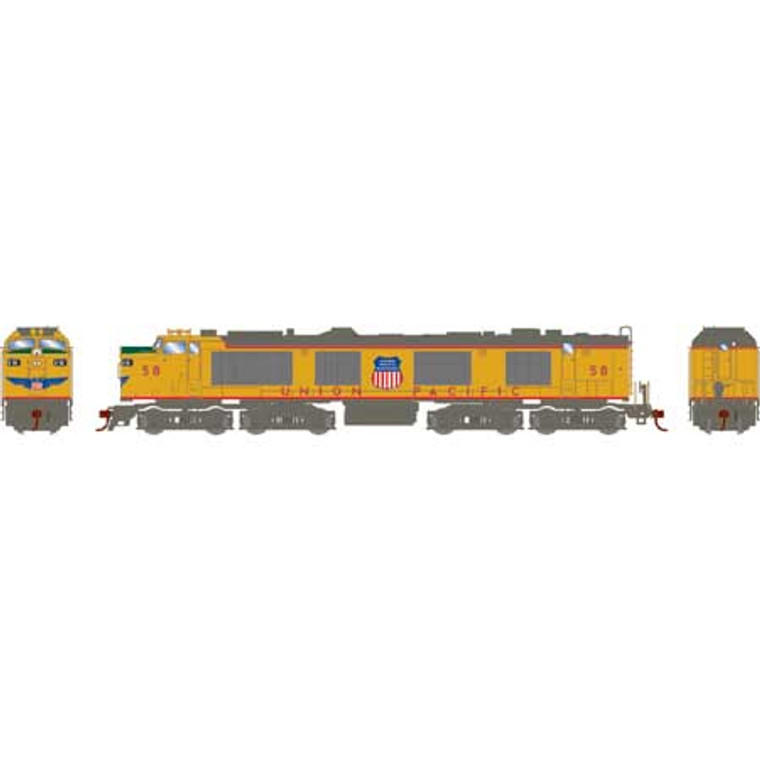
ATHG41143 Athearn HO Gas Turbine, UP #58, DC Silent/DCC Ready Locomotive
AthearnPre-order price of $289.95 will be invoiced when product arrives at The Train Exchange.
All DCC Ready locomotives can be upgraded to DCC or DCC/Sound in store for the cost of parts only. Please direct inquiries to sales@thetrainexchange.ca.
UP FEATURES:
- Gray Trucks
- FARR Grilles
Early on in their service lives, the turbines were equipped with stainless-steel FARR air grills on the sides. Grey trucks were standard until the painting diagram was revised in September 1955.
ROAD NUMBER SPECIFIC FEATURES:
#58
- Short nose door and handrails
GENESIS GAS TURBINE FEATURES:
- Fully assembled and ready for your layout or display
- Genesis driveline with 5-pole skew wound motor, precision machined flywheels, and multi-link drivetrain for trouble free operation
- Sound versions feature Soundtraxx Tsunami2 sound with 2 speakers installed
- DCC ready version wiring harness installed (21 pin harness)
- Razor sharp painting and printing
- McHenry® scale knuckle spring couplers installed
- Minimum radius: 18” — Recommended radius: 22”
PROTOTYPE SPECIFIC INFORMATION
After World War II, GE began work on a locomotive using a gas turbine power plant specifically designed for locomotive usage. The gas turbine had an advantage in that it could burn Bunker “C” fuel oil. Bunker “C” is a thick, low-grade oil that is a left-over when crude oil is refined into higher quality products like gasoline and diesel fuel. Being a residual of the refining process, it was both very cheap and widely available. GE’s locomotive gas turbine was about 20 feet long and created 4,500 horsepower, three times as much as a contemporary diesel.
GE’s test-bed and demonstrator gas turbine locomotive was completed in November 1948. Numbered as UP 50, it spent twenty-one months testing on the UP, covering 105,732 miles of operation and moving 349 million gross ton-miles of freight. UP’s first gas-turbine, numbered 51, was received at the Omaha shops on January 28, 1952. It had a full car body and a single cab. It carried 7,200 gallons of fuel oil and 1,000 gallons of diesel fuel. In addition to the gas turbine, there was also a 250 horsepower diesel engine. The diesel was used to move the locomotive around yards, power the auxiliaries, and crank the turbine. The locomotive weighed 551,720 pounds and was just over 83 feet long and stood 15 feet six inches tall. It rode on two sets of span-bolster AAR Type B trucks with a wheel arraignment of B+B-B+B. The gear ratio was 74:18 that gave a maximum speed of 65 miles per hour and a starting tractive effort of 137,930 pounds. Like contemporary diesels, the gas turbines were equipped with dynamic brakes.
The first of the series-production turbines were delivered in 1952, numbered 51-60, but equipped with a cab at one end only. Throughout their lives, changes were made to the top and side air intakes, in an attempt to better accommodate the various operating conditions. Between 1955 and 1956, tenders (converted from steam locomotive tenders) were added to the units, with a 24,000-gallon capacity. For a time, units 59 and 60 were used in an experimental 9000hp A-A set with a single tender in between. Retirements began in the early ‘60s and all were off roster by 1964.
The Athearn Genesis “Slab Side” turbines are equipped with many additional lighting features over previous runs. Separately-controlled MARS light, emergency stop “big hole” light, class lights, number boards, and backup light are all equipped. Combined with the industry’s most accurate Union Pacific colors, and the advanced capabilities of the Soundtraxx Tsunami2 Gas Turbine sound decoder, these impressive units will be at home on any late transition era UP roster.
Specifications
| DCC: | Ready/21-Pin NEM |
| SOUND: | Ready |
| PROTOTYPE MANUFACTURER: | GE |
| Axles: | 8 |
| LIGHTED: | LED Lighting |
| Minimum Age Recommendation: | 14 years |
| Is Assembly Required: | No |





